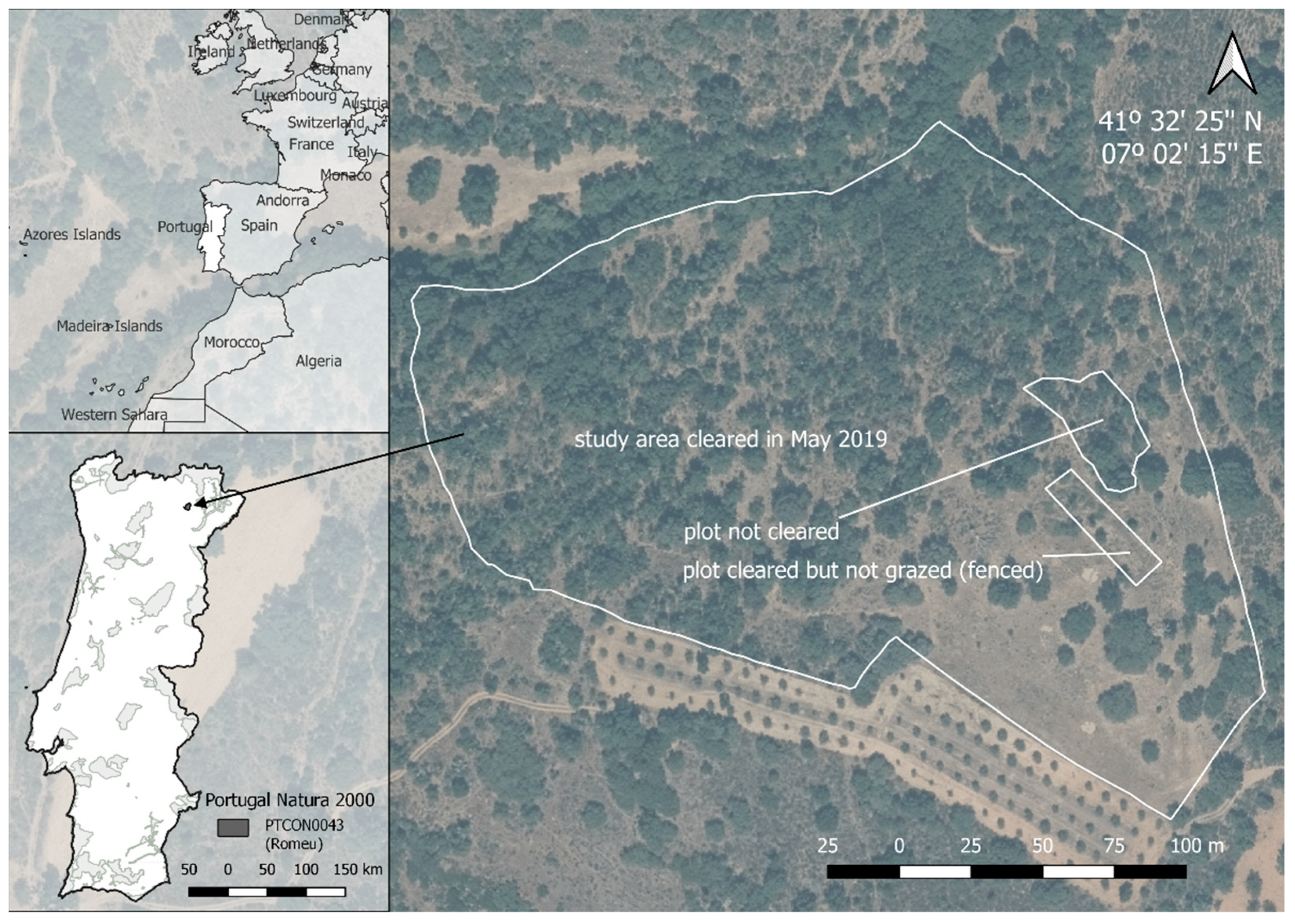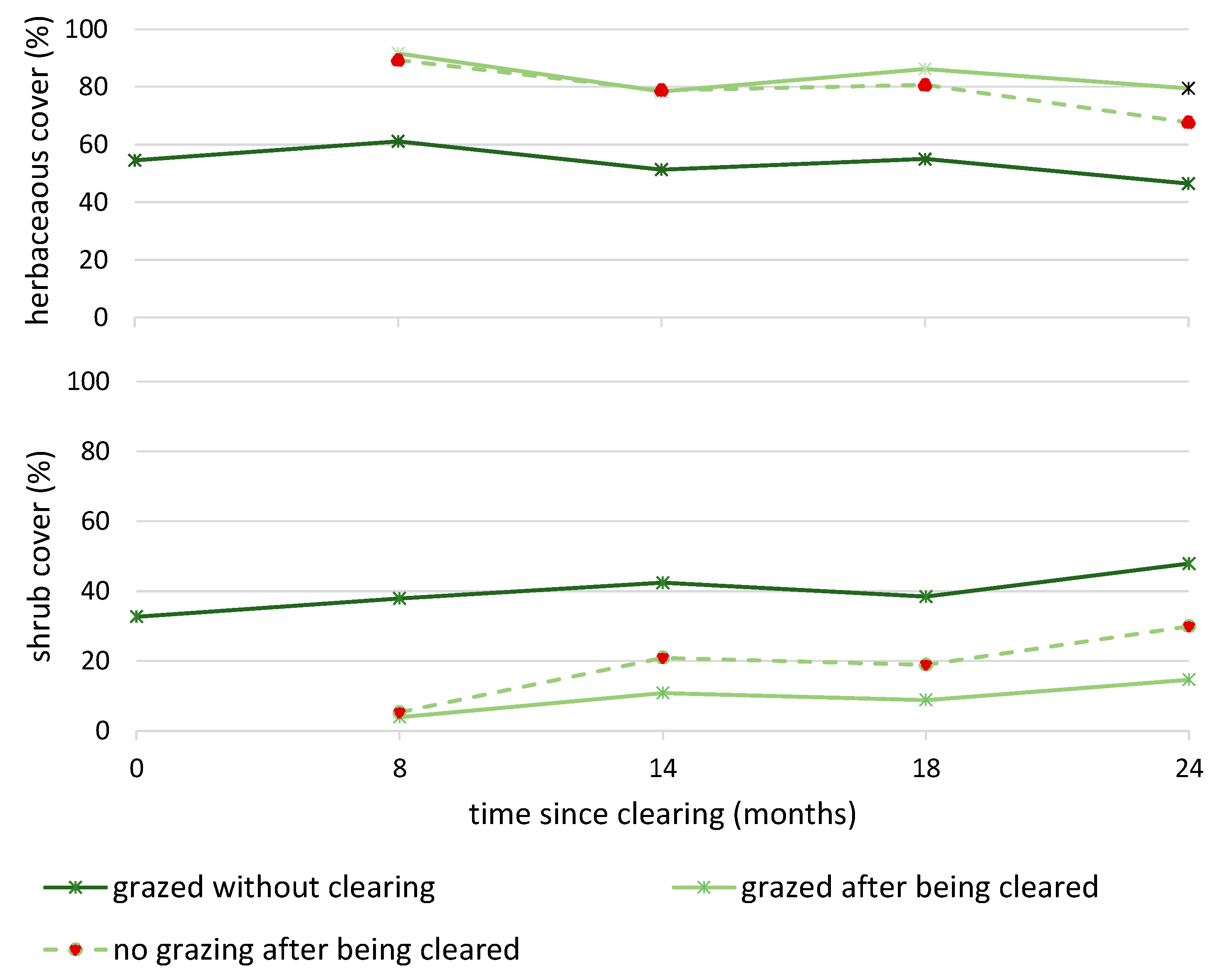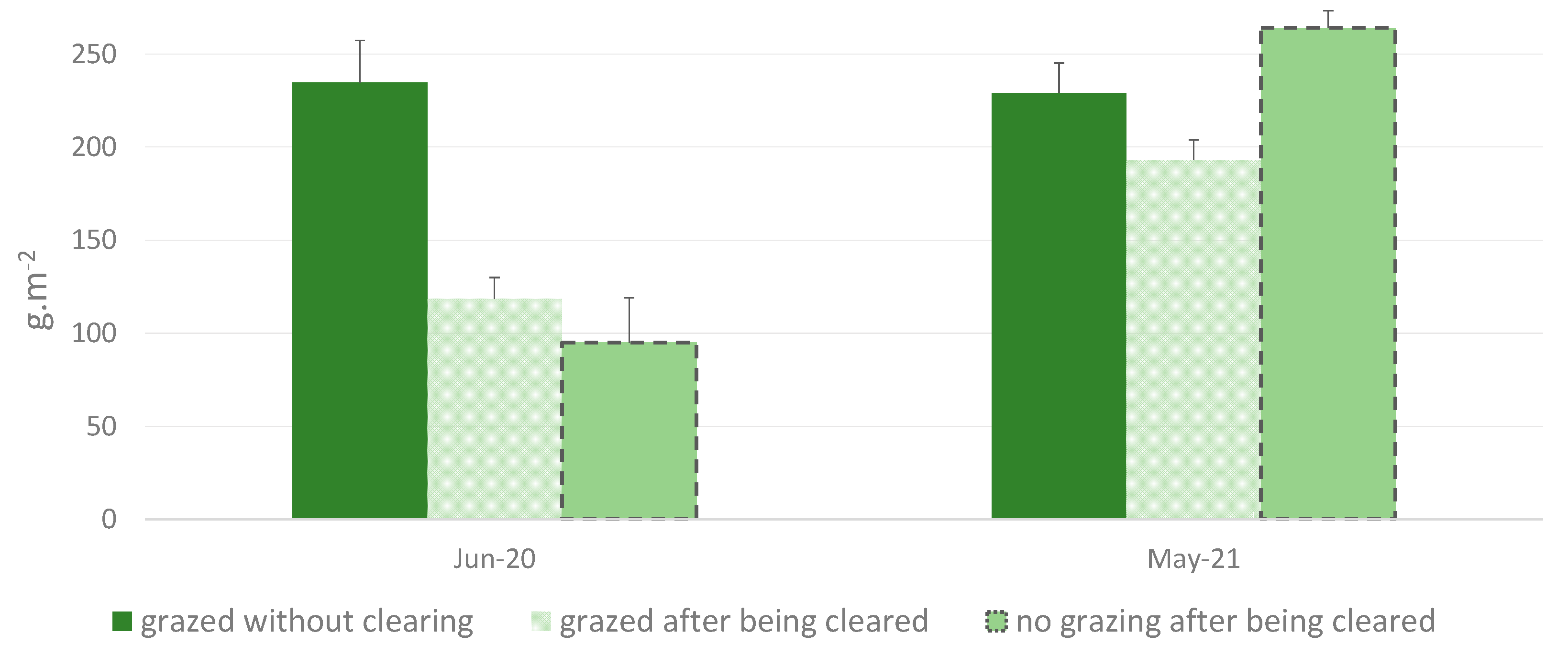Understory Clearing in Open Grazed Mediterranean Oak Forests: Assessing the Impact on Vegetation
Abstract
:1. Introduction
2. Materials and Methods
2.1. Study Area
2.2. Field Sampling, Vegetation Surveys, and Data Collection
2.2.1. Vegetation Structural Parameters
2.2.2. Floristic Inventories
2.2.3. Calculus
2.3. Statistical Analysis
3. Results
3.1. Plant Species Composition and Diversity
3.2. Structure
3.3. Herbaceous Biomass
4. Discussion
5. Conclusions
Supplementary Materials
Author Contributions
Funding
Institutional Review Board Statement
Informed Consent Statement
Data Availability Statement
Conflicts of Interest
References
- Hartel, T.; Plieninger, T.; Varga, A. Wood-pastures in Europe. In Europe’s Changing Woods and Forests: From Wildwood to Cultural Landscapes; Kirby, K.J., Walkins, C., Eds.; CAB International: Wallingford, UK, 2005; pp. 61–76. [Google Scholar]
- Plieninger, T.; Hartel, T.; Martín-López, B.; Beaufoy, G.; Bergmeier, E.; Kirby, K.; Montero, M.J.; Moreno, G.; Oteros-Rozas, E.; Van Uytvanck, J. Wood-pastures of Europe: Geographic coverage, social-ecological values, conservation management, and policy implications. Biol. Conserv. 2015, 190, 70–79. [Google Scholar] [CrossRef]
- Forejt, M.; Skalos, J.; Pereponova, A.; Plieninger, T.; Votja, J.; Šantrůčkovád, M. Changes and continuity of wood-pastures in the lowland landscape in Czechia. Appl. Geogr. 2017, 79, 235–244. [Google Scholar] [CrossRef]
- Gómez-Sal, A. The ecological rationale and nature conservation value of extensive livestock systems in the Iberian Peninsula. In Examples of European Agri-Environmental Schemes and Livestock Systems and Their Influence on Spanish Cultural Landscapes; Bunce, R.G.H., Pérez-Soba, M., Elbersen, B.S., Prados, M.J., Andersen, E., Bell, M., Smeets, P.J.A.M., Eds.; ALTERRA: Wageningen, The Netherlands, 2001; pp. 103–123. [Google Scholar]
- Dietre, B.; Reitmaier, T.; Walser, C.; Warnk, T.; Unkel, I.; Hajdas, I.; Lambers, K.; Reidl, D.; Haas, J.N. Steady transformation of primeval forest into subalpine pasture during the Late Neolithic to Early Bronze Age (2300−1700 BC) in the Silvretta Alps, Switzerland. Holocene 2020, 30, 355–368. [Google Scholar] [CrossRef]
- Garrido, P.; Elbakidze, M.; Angelstam, P.; Plieninger, T.; Pulido, F.; Moreno, G. Stakeholder perspectives of wood-pasture ecosystem services: A case study from Iberian dehesas. Land Use Policy 2017, 60, 324–333. [Google Scholar] [CrossRef]
- Bergmeier, E.; Petermann, J.; Schroder, E. Geobotanical survey of woodpasture habitats in Europe: Diversity, threats and conservation. Biodivers. Conserv. 2010, 19, 2995–3014. [Google Scholar] [CrossRef]
- Oksuz, D.P.; Aguiar, C.A.S.; Tápia, S.; Llop, E.; Lopes, P.; Serrano, A.R.M.; Leal, A.I.; Correia, O.; Matos, P.; Rainho, A.; et al. The contribution of small shrubby patches to the functional diversity of wood-pastures. Acta Oecol. 2020, 108, 103626. [Google Scholar] [CrossRef]
- Rolo, V.; Roces-Diaz, J.V.; Torralba, M.; Kay, S.; Fagerholm, N.; Aviron, S.; Burgess, P.; Crous-Duran, J.; Ferreiro-Dominguez, N.; Graves, A.; et al. Mixtures of forest and agroforestry alleviate trade-offs between ecosystem services in European rural landscapes. Ecosyst. Serv. 2021, 50, 101318. [Google Scholar] [CrossRef]
- Varela, E.; Olaizola, A.M.; Blasco, I.; Capdevila, C.; Lecegui, A.; Casasús, I.; Bernués, A.; Martín-Collado, D. Unravelling opportunities, synergies, and barriers for enhancing silvopastoralism in the Mediterranean. Land Use Policy 2022, 118, 106140. [Google Scholar] [CrossRef]
- Roellig, M.; Costa, A.; Garbarino, M.; Hanspach, J.; Hartel, T.; Jakobsson, S.; Lindborg, R.; Mayr, S.; Plieninger, T.; Sammul, M. Post hoc assessment of stand structure across European Wood-pastures: Implications for land use policy. Rangel. Ecol. Manag. 2018, 71, 526–535. [Google Scholar] [CrossRef]
- Azeda, C.; Guiomar, N.; Godinho, S.; Medeiros, J.P.; Pinto-Correia, T. The ambiguous role of agri-environment-climate measures in the safeguarding of High Nature Value Farming Systems: The case of the Montado in Portugal. Agric. Ecosyst. Environ. 2021, 319, 107562. [Google Scholar] [CrossRef]
- Costa, A.; Madeira, M.; Santos, J.L.; Plieninger, T.; Seixas, J. Fragmentation patterns of evergreen oak woodlands in Southwestern Iberia: Identifying key spatial indicators. J. Environ. Manag. 2014, 133, 18–26. [Google Scholar] [CrossRef] [PubMed]
- Sato, C.F.; Wood, J.T.; Stein, J.A.; Crane, M.; Okada, S.; Michael, D.R.; Kay, G.M.; Florance, D.; Seddon, J.; Gibbons, P.; et al. Natural tree regeneration in agricultural landscapes: The implications of intensification. Agric. Ecosyst. Environ. 2016, 230, 98–104. [Google Scholar] [CrossRef]
- Auer, A.; Maceira, N.; Nahuelhual, L. Agriculturisation and trade-offs between commodity production and cultural ecosystem services: A case study in Balcarce County. J. Rural Stud. 2017, 53, 88–101. [Google Scholar] [CrossRef]
- Bergmeier, E.; Roellig, M. Diversity, Threats and Conservation of European Wood-pastures. In European Wood-Pastures in Transition: A Social-Ecological Approach; Hartel, T., Plieninger, T., Eds.; Earthscan/Routledge: Abingdon, UK, 2014; pp. 19–38. [Google Scholar]
- Hartel, T.; Dorresteijn, I.; Klein, C.; Mathe, O.; Moga, C.I.; Ollerer, K.; Roellig, M.; von Wehrden, H.; Fischer, J. Wood-pastures in a traditional rural region of Eastern Europe: Characteristics, management and status. Biol. Conserv. 2013, 166, 267–275. [Google Scholar] [CrossRef]
- Insausti, K.; Beldarrain, L.R.; LAvín, M.P.; Aldai, N.; Mantecón, Á.R.; Sáez, J.L.; Canals, R.M. Horse meat production in northern Spain: Ecosystem services and sustainability in High Nature Value farmland. Anim. Front. 2021, 11, 47–54. [Google Scholar] [CrossRef] [PubMed]
- Lasanta, T.; Nadal-Romero, E.; Arnáez, J. Managing abandoned farmland to control the impact of re-vegetation on the environment. The state of the art in Europe. Environ. Sci. Policy 2015, 52, 99–109. [Google Scholar] [CrossRef]
- Moreno, G.; Franca, A.; Pinto-Correia, M.T.; Godinho, S. Multifunctionality and dynamics of silvopastoral systems. Opt. Méditerranéennes 2014, 109, 421–436. [Google Scholar]
- Durán, M.; Canals, R.M.; Sáez, J.L.; Ferrer, V.; Lera-López, F. Disruption of traditional land use regimes causes an economic loss of provisioning services in high-mountain grasslands. Ecosyst. Serv. 2020, 46, 101200. [Google Scholar] [CrossRef]
- San Emeterio, L.; Múgica, L.; Ugarte, M.D.; Goicoa, T.; Canals, R.M. Sustainability of traditional pastoral fires in highlands under global change: Effects on soil function and nutrient cycling. Agric. Ecosyst. Environ. 2016, 235, 155–163. [Google Scholar] [CrossRef]
- Guadilla-Sáez, S.; Pardo-de-Santayana, M.; Reyes-García, V. The role of traditional management practices in shaping a diverse habitat mosaic in a mountain region of Northern Spain. Land Use Policy 2019, 89, 104235. [Google Scholar] [CrossRef]
- Godinho, S.; Guiomar, N.; Machado, R.; Santos, P.; Sá-Sousa, P.; Fernandes, J.P.; Neves, N.; Pinto-Correia, T. Assessment of environment, land management, and spatial variables on recent changes in montado land cover in southern Portugal. Agrofor. Syst. 2016, 90, 177–192. [Google Scholar] [CrossRef] [Green Version]
- Pinto-Correia, T.; Azeda, C. Public policies creating tensions in Montado management models: Insights from farmers’ representations. Land Use Policy 2017, 64, 76–82. [Google Scholar] [CrossRef]
- Castro, M.; Ameray, A.; Castro, J.P. A new approach to quantify grazing pressure under Mediterranean pastoral systems using GIS and remote sensing. Int. J. Remote Sens. 2020, 41, 5371–5387. [Google Scholar] [CrossRef]
- Castillo-García, M.; Alados, C.L.; Ramos, J.; Moret, D.; Barrantes, O.; Pueyo, Y. Understanding herbivore-plant-soil feedbacks to improve grazing management on Mediterranean mountain grasslands. Agric. Ecosyst. Environ. 2022, 327, 107833. [Google Scholar] [CrossRef]
- Fuhlendorf, S.D.; Engle, D.M.; Kerby, J.; Hamilton, R. Pyric herbivory: Rewilding landscapes through the recoupling of fire and grazing. Conserv. Biol. 2009, 23, 588–598. [Google Scholar] [CrossRef] [PubMed]
- Thapa, S.K.; de Jong, J.F.; Hof, A.R.; Subedi, N.; Joshi, L.R. Fire and forage quality: Postfire regrowth quality and pyric herbivory in subtropical grasslands of Nepal. Ecol. Evol. 2022, 12, e8794. [Google Scholar] [CrossRef]
- Fernández, C.; Vega, J.A.; Fonturbel, T. Shrub resprouting response after fuel reduction treatments: Comparison of prescribed burning, clearing and mastication. J. Environ. Manag. 2013, 117, 235–241. [Google Scholar] [CrossRef]
- Bayne, K.C.; Clifford, V.R.; Baillie, B.R.; Pearce, H.G. Fire as a Land Management Tool: Rural Sector Perceptions of Burn-off Practice in New Zealand. Rangel. Ecol. Manag. 2019, 72, 523–532. [Google Scholar] [CrossRef]
- Baeza, M.J.; Raventós, J.; Escarré, A.; Vallejo, V.R. The effect of shrub clearing on the control of the fire-prone species Ulex parviflorus. For. Ecol. Manag. 2003, 186, 47–59. [Google Scholar] [CrossRef]
- Ruiz-Mirazo, J.; Robles, A.B.; González-Rebollar, J.L. Two-year evaluation of fuelbreaks grazed by livestock in the wildfire prevention program in Andalusia (Spain). Agric. Ecosyst. Environ. 2011, 141, 13–22. [Google Scholar] [CrossRef]
- Lasanta, T.; Cortijos-López, M.; Errea, M.P.; Khorchani, M.; Nadal-Romero, E. An environmental management experience to control wildfires in the mid-mountain Mediterranean area: Shrub clearing to generate mosaic landscapes. Land Use Policy 2022, 118, 106147. [Google Scholar] [CrossRef]
- Mena, Y.; Ruiz-Mirazo, J.; Ruiz, F.A.; Castel, J.M. Characterization and typification of small ruminant farms providing fuelbreak grazing services for wildfire prevention in Andalusia (Spain). Sci. Total Environ. 2016, 544, 211–219. [Google Scholar] [CrossRef] [PubMed]
- Martins, A.; Novais, A.; Santos, J.L.; Canadas, M.J. Experts’ multiple criteria evaluations of fuel management options to reduce wildfire susceptibility. The role of closer knowledge of the local socioeconomic context. Land Use Policy 2021, 108, 105580. [Google Scholar] [CrossRef]
- DiTomaso, J.M. Invasive weeds in rangelands: Species, impacts, and management. Weed Sci. 2000, 48, 255–265. [Google Scholar] [CrossRef]
- Fonseca, T.J.F.; Manso, F.C.S.T.; Martins, C.M.S.; Castro, M.M.F. A gestão florestal sustentável na prevenção do risco de incêndio: Silvicultura e pastoreio na redução da biomassa combustível. In Empreendedorismo e Inovação na Engenharia Florestal 3; Felsemburgh, C.A., Ed.; Atena Editora: Ponta Grossa, Brazil, 2001; pp. 54–71. [Google Scholar]
- Varela, E.; Górriz-Mifsud, E.; Ruiz-Mirazo, J.; López-i-Gelats, F. Payment for targeted grazing: Integrating local shepherds into wildfire prevention. Forests 2018, 9, 464. [Google Scholar] [CrossRef]
- Bartolomé, J.; Franch, J.; Plaixats, J.; Seligman, N.G. Grazing alone is not enough to maintain landscape diversity in the Montseny Biosphere Reserve. Agric. Ecosyst. Environ. 2000, 77, 267–273. [Google Scholar] [CrossRef]
- Álvarez-Martínez, J.; Gómez-Villar, A.; Lasanta, T. The use of goats grazing to restore pastures invaded by shrubs and avoid desertification: A preliminary case study in the Spanish Cantabrian Mountains. Land Degrad. Dev. 2016, 27, 3–13. [Google Scholar] [CrossRef]
- Bailey, D.W.; Mosley, J.C.; Estell, R.E.; Cibils, A.F.; Horney, M.; Hendrickson, J.R.; Walker, J.W.; Launchbaugh, K.L.; Burritt, E.A. Synthesis Paper: Targeted Livestock Grazing: Prescription for Healthy Rangelands. Rangel. Ecol. Manag. 2019, 72, 865–877. [Google Scholar] [CrossRef]
- Silva, V.; Catry, F.X.; Fernandes, P.M.; Rego, F.C.; Bugalho, M.N. Trade-offs between fire hazard reduction and conservation in a Natura 2000 shrub-grassland mosaic. Appl. Veg. Sci. 2020, 23, 39–52. [Google Scholar] [CrossRef]
- Castro, M.; Castro, J.P.; Pádua, L.; Castro, J. Regional Vegetation Monitoring Report of the Pilot Experiments; Open2preserve Projet; IPB: Bragança, Portugal, 2021. [Google Scholar]
- Canfield, R. Application of Line Interception Method in Sampling Range Vegetation. J. For. 1941, 39, 388–394. [Google Scholar]
- Daget, P.; Poissonet, J. Une Méthode d’Analyse Phytologique des Prairies’. Ann. Agron. 1971, 22, 5–41. [Google Scholar]
- Fuhlendorf, S.D.; Engle, D.M. Application of the fire-grazing interaction to restore a shifting mosaic on tallgrass prairie. J. Appl. Ecol. 2004, 41, 604–614. [Google Scholar] [CrossRef]
- Fernández, C.; Vega, J.; Fonturbel, T. Does shrub recovery differ after prescribed burning, clearing and mastication in a Spanish heathland? Plant Ecol. 2015, 216, 429–437. [Google Scholar] [CrossRef]
- Bashan, D.; Bar-Massada, A. Regeneration dynamics of woody vegetation in a Mediterranean landscape under different disturbance-based management treatments. J. Appl. Ecol. 2017, 20, 106–114. [Google Scholar] [CrossRef]
- Lanta, V.; Mudrák, O.; Liancourt, P.; Bartoš, M.; Chlumská, Z.; Dvorský, M.; Pusztaiová, Z.; Münzbergová, Z.; Sebek, P.; Čížek, L.; et al. Active management promotes plant diversity in lowland forests: A landscape-scale experiment with two types of clearings. For. Ecol. Manag. 2019, 448, 94–103. [Google Scholar] [CrossRef]
- Gao, J.; Carmel, Y. A global meta-analysis of grazing effects on plant richness. Agric. Ecosyst. Environ. 2020, 302, 107072. [Google Scholar] [CrossRef]
- Pérez-Ramos, M.; Zavala, M.A.; Marañón, T.; Díaz-Villa, M.D.; Valladares, F. Dynamics of understorey herbaceous plant diversity following shrub clearing of cork oak forests: A five-year study. For. Ecol. Manag. 2008, 255, 3242–3253. [Google Scholar] [CrossRef]
- Clemente, A.S.; Rego, F.C.; Correia, O.A. Demographic patterns and productivity of post-fire regeneration in Portuguese Mediterranean maquis. Int. J. Wildl. Fire 1996, 6, 5–12. [Google Scholar] [CrossRef]
- Perchemlides, K.A.; Muir, P.S.; Hosten, P.E. Responses of chaparral and oak woodland plant communities to fuel-reduction thinning in Southwestern Oregon. Rangel. Ecol. Manag. 2008, 61, 98–109. [Google Scholar] [CrossRef]
- Calvo, L.; Tárrega, R.; De Luis, E. The dynamics of Mediterranean shrubs species over 12 years following perturbations. Plant Ecol. 2002, 160, 25–42. [Google Scholar] [CrossRef]
- Fernández, C.; Vega, J.A. Shrub recovery after fuel reduction treatments in a gorse shrubland in northern Spain. J. Environ. Manag. 2016, 166, 211–216. [Google Scholar] [CrossRef] [PubMed]
- Fuentes, L.; Duguy, B.; Nadal-Sala, D. Short-term effects of spring prescribed burning on the understory vegetation of a Pinus halepensis forest in Northeastern Spain. Sci. Total Environ. 2018, 610–611, 720–731. [Google Scholar] [CrossRef] [PubMed]
- Mac Arthur, R.H.; Wilson, E.O. The Theory of Island Biogeography, 2nd ed.; Princeton University Press: Princeton, NJ, USA, 2001; p. 224. [Google Scholar]
- Capitanio, R.; Carcaillet, C. Post-fire Mediterranean vegetation dynamics and diversity: A discussion of succession models. For. Ecol. Manag. 2008, 255, 431–439. [Google Scholar] [CrossRef]
- Ximenes, F.; Stephens, M.; Brown, M.; Law, B.; Mylek, M.; Schirmer, J.; Sullivan, A.; McGuffog, T. Mechanical fuel load reduction in Australia: A potential tool for bushfire mitigation. Aust. For. 2017, 80, 88–98. [Google Scholar] [CrossRef]
- Bates, J.D.; Svejcar, T.; Miller, R.; Davies, K.W. Plant Community Dynamics 25 Years After Juniper Control. Rangel. Ecol. Manag. 2017, 70, 356–362. [Google Scholar] [CrossRef]
- Lasanta, T.; Khorchani, M.; Pérez-Cabello, F.; Errea, P.; Sáenz-Blanco, R.; Nadal-Romero, E. Clearing shrubland and extensive livestock farming: Active prevention to control wildfires in the Mediterranean mountains. J. Environ. Manag. 2018, 227, 256–266. [Google Scholar] [CrossRef]
- Casals, P.; Rios, A.I. Burning intensity and low light availability reduce resprouting ability and vigor of Buxus sempervirens L. after clearing. Sci. Total Environ. 2018, 627, 403–416. [Google Scholar] [CrossRef]
- Fick, S.E.; Nauman, T.W.; Brungard, C.C.; Duniway, M.C. What determines the effectiveness of Pinyon-Juniper clearing treatments? Evidence from the remote sensing archive and counter-factual scenarios. For. Ecol. Manag. 2022, 505, 119879. [Google Scholar] [CrossRef]
- Calleja, J.A.; Escolà, M.; Carvalho, J.; Forcadell, J.M.; Serrano, E.; Bartolomé, J. Cattle Grazing Fails to Control Shrub Encroachment in Mediterranean Landscapes. Rangel. Ecol. Manag. 2019, 72, 803–811. [Google Scholar] [CrossRef]
- Ameray, A.; Castro, J.P.; Castro, M. Potential greenhouse gas emissions mitigation through increased grazing pressure: A case study in North Portugal. Carbon Manag. 2022, 13, 142–153. [Google Scholar] [CrossRef]
- Etienne, M.; Mas, I.; Rigolot, E. Combining techniques of fuel reduction for fuel-break maintenance in the French Mediterranean region. Proceeding of the 2nd International Conference on Forest Fire Research, Coimbra, Portugal, 21–24 November 1994; Viegas, D.X., Ed.; Universidade de Coimbra: Coimbra, Portugal, 1994; II, pp. 713–721. [Google Scholar]
- Torrano, L.; Valderrábano, J. Grazing ability of European black pine understorey vegetation by goats. Small Rumin. Res. 2005, 58, 253–263. [Google Scholar] [CrossRef]
- Davies, K.W.; Wollstein, K.; Dragt, B.; O’Connor, C. Grazing management to reduce wildfire risk in invasive annual grass prone sagebrush communities. Rangelands 2022, 44, 194–199. [Google Scholar] [CrossRef]
- Öllerer, K.; Varga, A.; Kirby, K.; Demeter, L.; Biró, M.; Bölöni, J.; Molnár, Z. Beyond the obvious impact of domestic livestock grazing on temperate forest vegetation—A global review. Biol. Conserv. 2019, 237, 149–155. [Google Scholar] [CrossRef] [Green Version]
- Etienne, M. Aménagement de la forêt méditerranéenne contre les incendies et biodiversité. Rev. For. Fr. 2001, 53, 149–155. [Google Scholar] [CrossRef] [Green Version]
- Varela-Redondo, E.; Calatrava, J.; Ruiz-Mirazo, J.; Jiménez, R.; González Rebollar, J.L. El pastoreo en la prevención de incendios forestales: Análisis comparado de costes evitados frente a medios mecánicos de desbroce de la vegetación. Pequeños Rumiantes 2008, 9, 12–20. [Google Scholar]
- Ruiz-Mirazo, J.; Robles-Cruz, A.B.; Ramos-Font, M.E.; González-Rebollar, J.L. Las áreas pasto-cortafuegos como experiencia de selvicultura preventiva en los espacios forestales y agroforestales Mediterráneos: 1. Diseño. In Producciones Agroganaderas: Gestión Eficiente y Conservación del Medio Natural; Osoro, K., Argamentería, A., Larraceleta, A., Eds.; Servicio Regional de Investigación y Desarrollo Agroalimentario: Asturias, Spain, 2005; Volume 1, pp. 337–343. [Google Scholar]





Publisher’s Note: MDPI stays neutral with regard to jurisdictional claims in published maps and institutional affiliations. |
© 2022 by the authors. Licensee MDPI, Basel, Switzerland. This article is an open access article distributed under the terms and conditions of the Creative Commons Attribution (CC BY) license (https://creativecommons.org/licenses/by/4.0/).
Share and Cite
Castro, M.; Castro, J.P.; Castro, J. Understory Clearing in Open Grazed Mediterranean Oak Forests: Assessing the Impact on Vegetation. Sustainability 2022, 14, 10979. https://doi.org/10.3390/su141710979
Castro M, Castro JP, Castro J. Understory Clearing in Open Grazed Mediterranean Oak Forests: Assessing the Impact on Vegetation. Sustainability. 2022; 14(17):10979. https://doi.org/10.3390/su141710979
Chicago/Turabian StyleCastro, Marina, João Paulo Castro, and José Castro. 2022. "Understory Clearing in Open Grazed Mediterranean Oak Forests: Assessing the Impact on Vegetation" Sustainability 14, no. 17: 10979. https://doi.org/10.3390/su141710979




